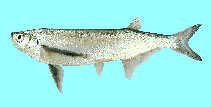Hochladen Photos und videos
Pictures | Google BildPelecus cultratus
Picture by Otel, V.
Pictures | Google BildPelecus cultratus
Picture by Otel, V.
Kazakhstan country information
Common names:
[No common name]
Occurrence: native
Salinity: freshwater
Abundance: | Ref:
Importance: | Ref:
Aquaculture: | Ref:
Regulations: | Ref:
Uses: no uses
Comments:
National Checklist:
Country Information: https://www.cia.gov/library/publications/resources/the-world-factbook/geos/kz.html
National Fisheries Authority:
Occurrences: Occurrences Point map
Main Ref: Muus, B.J. and P. Dahlström, 1968
National Database:
Occurrence: native
Salinity: freshwater
Abundance: | Ref:
Importance: | Ref:
Aquaculture: | Ref:
Regulations: | Ref:
Uses: no uses
Comments:
National Checklist:
Country Information: https://www.cia.gov/library/publications/resources/the-world-factbook/geos/kz.html
National Fisheries Authority:
Occurrences: Occurrences Point map
Main Ref: Muus, B.J. and P. Dahlström, 1968
National Database:
Common names from other countries
Klassifizierung / Names Namen | Synonyme | Catalog of Fishes(Gattung, Arten) | ITIS | CoL | WoRMS | Cloffa
> Cypriniformes (Carps) > Leuciscidae (Minnows) > Leuciscinae
Etymology: Pelecus: Greek, pelekys = hatchet (Ref. 45335).
More on author: Linnaeus.
Etymology: Pelecus: Greek, pelekys = hatchet (Ref. 45335).
More on author: Linnaeus.
Environment: milieu / climate zone / depth range / distribution range Ökologie
; süßwasser; brackwasser pelagisch; anadrom (Ref. 51243); tiefenbereich 20 - ? m (Ref. 9696). Temperate; 10°C - 20°C (Ref. 2059); 63°N - 36°N, 8°E - 73°E
Verbreitung Länder | FAO Gebiete | Ecosystems | Vorkommen | Point map | Einführungen | Faunafri
Eurasia: Black Sea, Caspian Sea and Aral Sea basins; Baltic basin from Vistula to Neva drainages, southern Sweden and Finland, Lakes Ladoga and Onega. Occasionally on Baltic coast west of Vistula and on Finnish coast north of 61°N (Ref. 59043).
Length at first maturity / Size / Gewicht / Alter
Maturity: Lm ? range ? - ? cm
Max length : 60.0 cm TL Männchen/unbestimmt; (Ref. 556); common length : 25.0 cm TL Männchen/unbestimmt; (Ref. 556); max. veröff. Gewicht: 2.0 kg (Ref. 556); max. veröff. Alter: 11 Jahre (Ref. 27368)
Max length : 60.0 cm TL Männchen/unbestimmt; (Ref. 556); common length : 25.0 cm TL Männchen/unbestimmt; (Ref. 556); max. veröff. Gewicht: 2.0 kg (Ref. 556); max. veröff. Alter: 11 Jahre (Ref. 27368)
Kurzbeschreibung Bestimmungsschlüssel | Morphologie | Morphometrie
Mouth oblique. Low wavy lateral line. Belly with a sharp edge (Ref. 35388).
Adults shoal in lower reaches of large rivers and in the eastern Baltic, the Caspian Sea and the Aral Sea. They spawn in spring in midstream (Ref. 9696) and return to estuaries to forage immediately after spawning (Ref. 59043). Juveniles may migrate to estuaries during first summer (Ref. 59043). Feed on zooplankton, terrestrial invertebrates and small fish (Ref. 59043).
Life cycle and mating behavior Geschlechtsreife | Fortpflanzung | Ablaichen | Eier | Fecundity | Larven
Open water egg scatterers.
Hauptreferenz
Upload your references | Referenzen | Koordinator | Partner
Muus, B.J. and P. Dahlström, 1968. Süßwasserfische. BLV Verlagsgesellschaft, München. 224 p. (Ref. 556)
IUCN Rote Liste Status (Ref. 130435: Version 2024-2)
nicht bedroht (LC) ; Date assessed: 29 May 2022
Bedrohung für Menschen
Harmless
Nutzung durch Menschen
Fischereien: weniger kommerziell
FAO(Aquaculture systems: production; Fischereien: production; publication : search) | FishSource | Sea Around Us
Mehr Information
Population dynamics
Growth parameters
Max. ages / sizes
Length-weight rel.
Length-length rel.
Längenhäufigkeiten
Mass conversion
Rekrutierung
Dichte
Growth parameters
Max. ages / sizes
Length-weight rel.
Length-length rel.
Längenhäufigkeiten
Mass conversion
Rekrutierung
Dichte
Life cycle
Fortpflanzung
Geschlechtsreife
Fecundity
Ablaichen
Spawning aggregations
Eier
Eientwicklung
Larven
Larven Pop.Dyn.
Fortpflanzung
Geschlechtsreife
Fecundity
Ablaichen
Spawning aggregations
Eier
Eientwicklung
Larven
Larven Pop.Dyn.
Anatomy
Kiemenoberfläche
Brain
Otolith
Kiemenoberfläche
Brain
Otolith
Physiology
Body composition
Nutrients
Oxygen consumption
Swimming type
Swimming speed
Visual pigments
Fish sound
Diseases & Parasites
Toxicity (LC50s)
Body composition
Nutrients
Oxygen consumption
Swimming type
Swimming speed
Visual pigments
Fish sound
Diseases & Parasites
Toxicity (LC50s)
Human related
Aquaculture systems
Aquakultur Profile
Zuchtlinien
Ciguatera cases
Stamps, coins, misc.
Aquaculture systems
Aquakultur Profile
Zuchtlinien
Ciguatera cases
Stamps, coins, misc.
Tools
E-book | Feldführer | Längenhäufigkeits Tool | Lebensdaten Tool | Punkt Karte | Classification Tree
| Catch-MSY |
Zusatzinformationen
Download XML
Zusammenfassung | Point data | Namen | Photos
Internet Quellen
Alien/Invasive Species database | Aquatic Commons | BHL | Cloffa | BOLDSystems | Websites from users | FishWatcher Einträge suchen | CISTI | Catalog of Fishes(Gattung, Arten) | DiscoverLife | ECOTOX | Faunafri | Fishtrace | GenBank(Genom, nucleotide) | GloBI | GOBASE | | Google Books | Google Scholar | Google | IGFA World Record | MitoFish | Nationale Datenbanken | Otolith Atlas of Taiwan Fishes | Öffentliche Aquarien | PubMed | Reef Life Survey | Scirus | SeaLifeBase | Tree of Life | Wikipedia(Gehe zu, Suchen) | World Records Freshwater Fishing | Zoological Record
Estimates based on models
Phylogenetic diversity index (Ref. 82804): PD50 = 1.0000 [Uniqueness, from 0.5 = low to 2.0 = high].
Bayesian length-weight: a=0.00724 (0.00358 - 0.01465), b=3.14 (2.97 - 3.31), in cm Total Length, based on LWR estimates for this (Sub)family-body shape (Ref. 93245).
Trophic level (Ref. 69278): 3.6 ±0.53 se; based on food items.
Widerstandsfähigkeit (Ref. 120179): mittel, Verdopplung der Population dauert 1,4 - 4,4 Jahre. (K=0.20; tmax=11).
Fishing Vulnerability (Ref. 59153): Moderate to high vulnerability (50 of 100).




